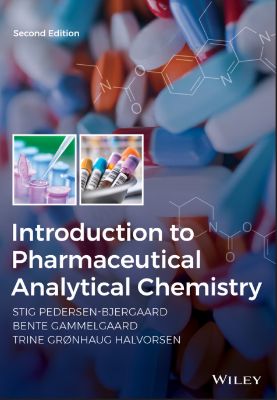Introduction to Pharmaceutical Analytical Chemistry

Námskeið
- LYF403G Lyfjagreining
Ensk lýsing:
This textbook is the first to present a systematic introduction to chemical analysis of pharmaceutical raw materials, finished pharmaceutical products, and of drugs in biological fluids, which are carried out in pharmaceutical laboratories worldwide. In addition, this textbook teaches the fundamentals of all the major analytical techniques used in the pharmaceutical laboratory, and teaches the international pharmacopoeias and guidelines of importance for the field.
It is primarily intended for the pharmacy student, to teach the requirements in “analytical chemistry” for the 5 years pharmacy curriculum, but the textbook is also intended for analytical chemists moving into the field of pharmaceutical analysis. Addresses the basic concepts, then establishes the foundations for the common analytical methods that are currently used in the quantitative and qualitative chemical analysis of pharmaceutical drugs Provides an understanding of common analytical techniques used in all areas of pharmaceutical development Suitable for a foundation course in chemical and pharmaceutical sciences Aimed at undergraduate students of degrees in Pharmaceutical Science/Chemistry Analytical Science/Chemistry, Forensic analysis Includes many illustrative examples.
Lýsing:
The definitive textbook on the chemical analysis of pharmaceutical drugs - fully revised and updated Introduction to Pharmaceutical Analytical Chemistry enables students to gain fundamental knowledge of the vital concepts, techniques and applications of the chemical analysis of pharmaceutical ingredients, final pharmaceutical products and drug substances in biological fluids. A unique emphasis on pharmaceutical laboratory practices, such as sample preparation and separation techniques, provides an efficient and practical educational framework for undergraduate studies in areas such as pharmaceutical sciences, analytical chemistry and forensic analysis.
Suitable for foundational courses, this essential undergraduate text introduces the common analytical methods used in quantitative and qualitative chemical analysis of pharmaceuticals. This extensively revised second edition includes a new chapter on chemical analysis of biopharmaceuticals, which includes discussions on identification, purity testing and assay of peptide and protein-based formulations.
Also new to this edition are improved colour illustrations and tables, a streamlined chapter structure and text revised for increased clarity and comprehension. Introduces the fundamental concepts of pharmaceutical analytical chemistry and statistics Presents a systematic investigation of pharmaceutical applications absent from other textbooks on the subject Examines various analytical techniques commonly used in pharmaceutical laboratories Provides practice problems, up-to-date practical examples and detailed illustrations Includes updated content aligned with the current European and United States Pharmacopeia regulations and guidelines Covering the analytical techniques and concepts necessary for pharmaceutical analytical chemistry , Introduction to Pharmaceutical Analytical Chemistry is ideally suited for students of chemical and pharmaceutical sciences as well as analytical chemists transitioning into the field of pharmaceutical analytical chemistry.
Annað
- Höfundar: Stig Pedersen-Bjergaard, Bente Gammelgaard, Trine G. Halvorsen
- Útgáfa:2
- Útgáfudagur: 2019-02-11
- Hægt að prenta út 10 bls.
- Hægt að afrita 2 bls.
- Format:ePub
- ISBN 13: 9781119362753
- Print ISBN: 9781119362722
- ISBN 10: 111936275X
Efnisyfirlit
- Preface to the Second Edition
- Abbreviations
- Symbols and Units
- Constants
- Greek alphabet
- 1 Introduction to Pharmaceutical Analytical Chemistry
- 1.1 Introduction
- 1.2 Pharmaceutical Analytical Chemistry
- 1.3 This Textbook
- 2 Marketing Authorizations, Pharmaceutical Manufacturing, and International Pharmacopoeias
- 2.1 Introduction
- 2.2 Marketing Authorization and Industrial Production
- 2.3 Pharmacopoeias
- 2.4 Life Time of Pharmaceutical Preparations and Ingredients
- 3 Fundamentals of Bases, Acids, Solubility, Polarity, Partition, and Stereochemistry
- 3.1 Acids, Bases, pH, and pK a
- 3.2 Buffers
- 3.3 Acid and Base Properties of Drug Substances
- 3.4 Distribution Between Phases
- 3.5 Stereoisomers
- 3.6 Active Pharmaceutical Ingredients – A Few Examples
- 3.7 Stability of Drug Substances
- 4 Fundamentals of Pharmaceutical Analytical Chemistry
- 4.1 Pharmaceutical Analytical Chemistry
- 4.2 How to Specify Quantities, Concentrations, and Compositions of Mixtures
- 4.3 Laboratory Equipment
- 4.4 How to Make Solutions and Dilutions
- 4.5 Errors, Accuracy, and Precision
- 4.6 Statistical Tests
- 4.7 Linear Regression Analysis
- 4.8 How to Present an Analytical Result
- 4.9 Additional Words and Terms
- 5 Titration
- 5.1 Introduction
- 5.2 Potentiometric Titration and Electrodes
- 5.3 Aqueous Acid–Base Titrations
- 5.4 Titration in Non‐aqueous Solvents
- 5.5 Redox Titrations
- 5.6 Alternative Principles of Titration
- 6 Introduction to Spectroscopic Methods
- 6.1 Electromagnetic Radiation
- 6.2 Molecules and Absorption of Electromagnetic Radiation
- 6.3 Absorbing Structures – Chromophores
- 6.4 Fluorescence
- 6.5 Atoms and Electromagnetic Radiation
- 7 UV‐Vis Spectrophotometry
- 7.1 Areas of Use
- 7.2 Quantitation
- 7.3 Absorbance Dependence on Measurement Conditions
- 7.4 Identification
- 7.5 Instrumentation
- 7.6 Practical Work and Method Development
- 7.7 Test of Spectrophotometers
- 7.8 Fluorimetry
- 8 IR Spectrophotometry
- 8.1 IR Spectrophotometry
- 8.2 Instrumentation
- 8.3 Recording by Transmission, Diffuse Reflectance, and Attenuated Total Reflection
- 8.4 Instrument Calibration
- 8.5 NIR Spectrophotometry
- 9 Atomic Spectrometry
- 9.1 Applications of Atomic Spectrometry
- 9.2 Atomic Absorption Spectrometry (AAS)
- 9.3 AAS Instrumentation
- 9.4 AAS Practical Work and Method Development
- 9.5 Atomic Emission Spectrometry (AES)
- 9.6 Flame Photometry
- 9.7 Inductively Coupled Plasma Emission Spectrometry
- 9.8 Inductively Coupled Plasma Mass Spectrometry
- 10 Introduction to Chromatography
- 10.1 Introduction
- 10.2 General Principles
- 10.3 Retention
- 10.4 Efficiency
- 10.5 Selectivity
- 10.6 Resolution
- 10.7 Peak Symmetry
- 10.8 The Dynamics of Chromatography
- 11 Separation Principles in Liquid Chromatography
- 11.1 Introduction
- 11.2 Reversed‐Phase Chromatography
- 11.3 Ion‐Pair Chromatography
- 11.4 Normal‐Phase Chromatography
- 11.5 Thin‐Layer Chromatography
- 11.6 Hydrophilic Interaction Chromatography
- 11.7 Ion Exchange Chromatography
- 11.8 Size Exclusion Chromatography
- 11.9 Chiral Separations
- 11.10 Supercritical Fluid Chromatography
- 12 High Performance Liquid Chromatography
- 12.1 Introduction
- 12.2 The Column
- 12.3 Scaling Between Columns
- 12.4 Pumps
- 12.5 Injectors
- 12.6 Detectors
- 12.7 Mobile Phases
- 12.8 Solvents for Sample Preparation
- 13 Gas Chromatography
- 13.1 Introduction
- 13.2 Basic Principle
- 13.3 Instrumentation
- 13.4 Carrier Gas
- 13.5 Stationary Phases
- 13.6 Retention
- 13.7 Columns
- 13.8 Injection
- 13.9 Detectors
- 13.10 Derivatization
- 14 Electrophoretic Methods
- 14.1 Introduction
- 14.2 Principle and Theory
- 14.3 Gel Electrophoresis
- 14.4 SDS‐PAGE
- 14.5 Western Blotting
- 14.6 Isoelectric Focusing
- 14.7 Capillary Electrophoresis
- 15 Mass Spectrometry
- 15.1 Introduction
- 15.2 Basic Theory of Mass Spectrometry
- 15.3 Ionization
- 15.4 The Mass Spectrometer as a Chromatographic Detector – Data Acquisition
- 15.5 Quantitation by MS
- 15.6 Identification by MS
- 15.7 Instrumentation
- 16 Sample Preparation
- 16.1 When is Sample Preparation Required?
- 16.2 Main Strategies
- 16.3 Recovery and Enrichment
- 16.4 Liquid–Liquid Extraction
- 16.5 Solid–Liquid Extraction
- 16.6 Solid Phase Extraction
- 17 Quality of Analytical Data and Validation
- 17.1 Instrumental Signals
- 17.2 Calibration Methods
- 17.3 Analytical Procedures
- 17.4 Validation
- 17.5 System Suitability
- 18 Chemical Analysis of Pharmaceutical Ingredients
- 18.1 Pharmaceutical Ingredients, Production, and Control
- 18.2 Pharmacopoeia Monographs
- 18.3 Impurities in Pharmaceutical Ingredients
- 18.4 Identification of Pharmaceutical Ingredients
- 18.5 Impurity Testing of Pharmaceutical Ingredients (Pure Chemical Ingredients)
- 18.6 Identification and Impurity Testing of Organic Multi‐Chemical Ingredients
- 18.7 Assay of Pharmaceutical Ingredients
- 18.8 Chemical Analysis of Pharmaceutical Ingredients Not Included in Pharmacopoeias
- 19 Chemical Analysis of Pharmaceutical Preparations
- 19.1 Chemical Analysis of Pharmaceutical Preparations
- 19.2 Monographs and Chemical Analysis
- 19.3 Identification of the API
- 19.4 Assay of the Active Pharmaceutical Ingredient
- 19.5 Chemical Tests for Pharmaceutical Preparations
- 20 Bioanalysis Chemical Analysis of Pharmaceuticals in Biological Fluids
- 20.1 Bioanalysis
- 20.2 Biological Fluids
- 20.3 Bioanalytical Methods – An Overview
- 20.4 Sampling
- 20.5 Sample Preparation
- 20.6 Separation and Detection
- 20.7 Quantitation
- 20.8 Screening
- 21 Chemical Analysis of Biopharmaceuticals
- 21.1 Biopharmaceuticals
- 21.2 Biopharmaceuticals versus Small Molecule APIs
- 21.3 Biopharmaceuticals and Pharmacopoeias
- 21.4 Production of Biopharmaceuticals
- 21.5 Identification Procedures for Biopharmaceuticals (Active Substance)
- 21.6 Impurity Tests for Biopharmaceuticals (Active Substances)
- 21.7 Assay of Biopharmaceuticals (Active Substance)
- 21.8 Monoclonal Antibodies
- 21.9 Analysis of Biopharmaceutical Products
- 21.10 Bioanalysis of Biopharmaceuticals Using LC‐MS/MS
- Index
- End User License Agreement
UM RAFBÆKUR Á HEIMKAUP.IS
Bókahillan þín er þitt svæði og þar eru bækurnar þínar geymdar. Þú kemst í bókahilluna þína hvar og hvenær sem er í tölvu eða snjalltæki. Einfalt og þægilegt!Rafbók til eignar
Rafbók til eignar þarf að hlaða niður á þau tæki sem þú vilt nota innan eins árs frá því bókin er keypt.
Þú kemst í bækurnar hvar sem er
Þú getur nálgast allar raf(skóla)bækurnar þínar á einu augabragði, hvar og hvenær sem er í bókahillunni þinni. Engin taska, enginn kyndill og ekkert vesen (hvað þá yfirvigt).
Auðvelt að fletta og leita
Þú getur flakkað milli síðna og kafla eins og þér hentar best og farið beint í ákveðna kafla úr efnisyfirlitinu. Í leitinni finnur þú orð, kafla eða síður í einum smelli.
Glósur og yfirstrikanir
Þú getur auðkennt textabrot með mismunandi litum og skrifað glósur að vild í rafbókina. Þú getur jafnvel séð glósur og yfirstrikanir hjá bekkjarsystkinum og kennara ef þeir leyfa það. Allt á einum stað.
Hvað viltu sjá? / Þú ræður hvernig síðan lítur út
Þú lagar síðuna að þínum þörfum. Stækkaðu eða minnkaðu myndir og texta með multi-level zoom til að sjá síðuna eins og þér hentar best í þínu námi.
Fleiri góðir kostir
- Þú getur prentað síður úr bókinni (innan þeirra marka sem útgefandinn setur)
- Möguleiki á tengingu við annað stafrænt og gagnvirkt efni, svo sem myndbönd eða spurningar úr efninu
- Auðvelt að afrita og líma efni/texta fyrir t.d. heimaverkefni eða ritgerðir
- Styður tækni sem hjálpar nemendum með sjón- eða heyrnarskerðingu
- Gerð : 208
- Höfundur : 14630
- Útgáfuár : 2019
- Leyfi : 380


